Working in an even older medium, Jennefer Hoffmann’s stoneware works, at Volume Gallery, are totems that take on a ritualistic aura. Their tiered structures suggest a utility lost in history while their capstones—an eye, an orange ball, a mass of lumps—further heighten the mystery. Read the full article here.
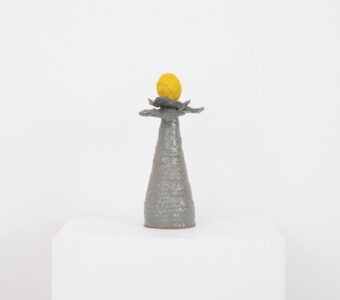
WSJ: Trendspotting at NADA New York 2023
May 20, 2023
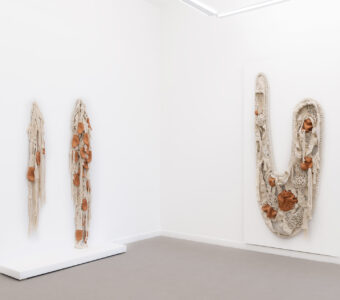
Chicago Reader: Specters of material Tanya Aguiñiga’s “Swallowing Dirt” unravels the body with fiber and clay.
May 12, 2023
At first glance, Tanya Aguiñiga’s “Swallowing Dirt” seems to gesture to the phantasmagoric. Her spectral rope and terra-cotta sculptures fill Volume Gallery, suspended from the walls and ceiling. The figures ostensibly depict the uncanny body, which produces our premature illusory response. But under closer examination, Aguiñiga’s sculptures are corporeal. She threads together her two material disciplines to create a series of haunting forms that concretize when we approach them.
“Swallowing Dirt” features eight unconventional portraits—sculptures that reimagine the immaterial “self” as tactile. The two ostensibly incompatible mediums—ceramic and fiber—twine together to create haunting figures. The terra-cotta and off-loom weaving blend together in an homage to Aguiñiga’s Mexican heritage. Emotional Body I spills from the gallery wall, engulfing a series of terra-cotta hands immersed in the rope sculpture. Similarly, the wall-hung Internal Body II holds terra-cotta internal organs within its fiber “belly.” Aguiñiga ventures to explore the esoteric, hanging Metaphysical Body II from the ceiling to create a hauntingly inviting display. Read the full review here.
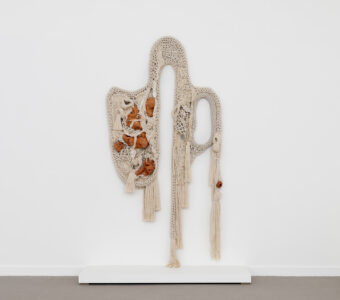
NewCity: Getting Her Hands Dirty: A Review of Tanya Aguiñiga’s “Swallowing Dirt” at Volume Gallery
The artist has a long history of weaving and working within (and beyond) traditional craft techniques. She adds layers in the form of meaningful materials that nod to her Mexican heritage. Think reddish-brown ceramics, clay and natural fibers. The outcome is a heavily textured work that feels tactile—soft and powerful at once.
Another major influence on Aguiñiga’s artistic and activism practice: her childhood. The Los Angeles-based artist was raised in Tijuana, and had to cross the border daily as a child to attend school in San Diego. This binational experience has proved incredibly formative of her perspective and has heavily impacted her life and career. To this day, this memory still feels fresh. Read the full review here.
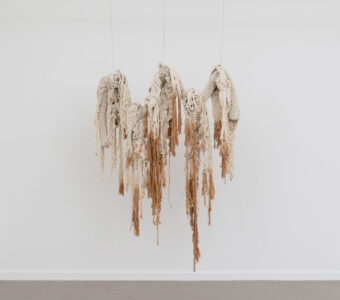
Elle Decor: Tanya Aguiñiga at Volume Gallery
In “Swallowing Dirt,” Los Angeles–based artist Tanya Aguiñiga’s fifth show at Volume Gallery, weavings hang in place of the human body and suggest elements of an artist’s specific human experience. With textile sculptures suspended both from the ceiling and hung on the wall, Aguiñiga stretches what can be considered a portrait by incorporating vaguely human elements (like terra-cotta hands and internal organs) into forms that feel sentient and static in equal parts. Most of the work is constructed with cotton rope, some of it dyed with terra-cotta, while fired terra-cotta elements are woven in. Her bodies are also doorways, referencing a childhood spent crossing the border between Tijuana, Mexico, and San Diego daily, and form a bridge between her artistic concerns and her work as an activist. The show is wonderfully refreshing and impressive in scale. Read the full article here.
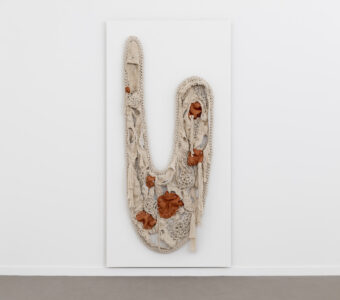
Design Miami The Buzz: Tanya Aguiñiga: Swallowing Dirt at Volume Gallery
May 2, 2023
Chicago’s Volume Gallery presents Swallowing Dirt, a solo show by award-winning artist, activist, and craftsperson Tanya Aguiñiga. The LA-based multitalent’s latest works are conceived as unconventional portraits—symbolic abstractions of the human experience incorporating cotton rope weavings and ceramic renditions of body parts—and a continuation of her investigations into identity, place, and craft. Raised in Tijuana Mexico, Aguiñiga crossed the border daily as a child to attend school in San Diego, and her binational experience continues to influence her practice today. By using clay from Mexico and the US, Aguiñiga addresses issues such as colonization, commodification, and ownership of land. Til June 17. Read more here.